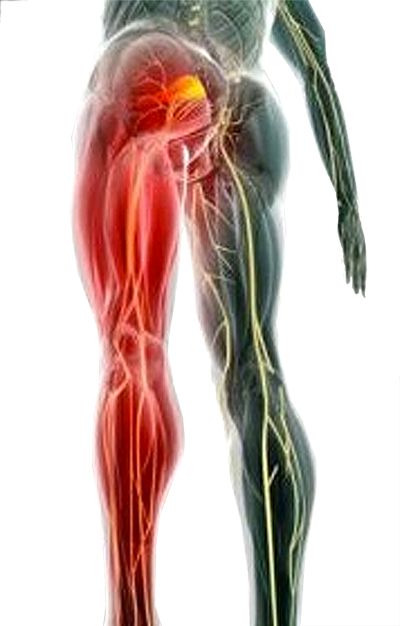
Sciatica, known as Gridhrasi (ग्रिध्रसी) in Ayurveda, is a painful condition characterized by radiating pain along the sciatic nerve pathway, from the lower back through the buttocks and down the leg. The term “Gridhrasi” comes from “Gridhra” (vulture) because the affected person’s gait often resembles that of a vulture due to the pain and limping.
Ayurveda primarily attributes sciatica to the vitiation of Vata Dosha, often in combination with Kapha Dosha (Vata-Kaphaja Gridhrasi) or sometimes Pitta Dosha. Vata, being responsible for movement and nerve functions, gets aggravated and obstructs the normal flow of energy (Prana) and nutrients in the affected area, leading to pain, stiffness, numbness, and tingling.
Ayurvedic treatment for sciatica is comprehensive and aims to:
- Pacify aggravated Vata Dosha.
- Reduce pain, inflammation, and stiffness.
- Nourish and strengthen the nerves, muscles, and spinal tissues.
- Remove accumulated toxins (Ama) that might be obstructing channels.
- Improve mobility and prevent recurrence.
Here’s a detailed look at Ayurvedic approaches for sciatica:
1. Shodhana (Panchakarma – Detoxification and Purification Therapies): Panchakarma is highly effective for sciatica as it addresses the root cause by eliminating accumulated toxins and balancing the doshas. These therapies are usually performed after a preparatory phase (Purvakarma) of internal and external oleation (Snehana) and fomentation (Swedana).
- Abhyanga (Herbal Oil Massage): Regular massage with warm medicated oils is fundamental. Oils like Mahanarayana Thailam, Kottamchukkadi Thailam, Dhanwantharam Thailam, Sahacharadi Thailam, Nirgundi Taila, or simple warm sesame oil are used. Abhyanga helps to:
- Pacify Vata.
- Reduce pain, stiffness, and muscle spasms.
- Improve circulation to the affected area.
- Nourish muscles, ligaments, and nerves.
- Swedana (Fomentation/Steam Therapy): Done after Abhyanga, Swedana helps to enhance the absorption of oil, relax muscles, reduce stiffness, and promote sweating for toxin elimination. Types commonly used for sciatica include:
- Kizhi (Pinda Sweda): Herbal poultices or boluses (Pottalis) are made using medicated leaves (Elakizhi), herbal powders (Podi Kizhi), or special Navara rice (Navarakizhi) cooked in milk and herbal decoctions. These warm poultices are applied to the affected lower back and leg to provide deep heat, reduce pain, inflammation, and stiffness.
- Pizhichil (Oil Bath Therapy): Continuous pouring of warm medicated oil over the entire body (or affected area) with gentle massage. This is deeply soothing for the nerves and muscles, significantly pacifying Vata.
- Nadi Swedana: Localized steam applied to the affected area using a tube, directing medicated steam precisely.
- Kati Basti (Localized Oil Retention on Lower Back): A dam made of dough is placed on the lower back, and warm medicated oil (like Mahanarayana Thailam, Ksheerabala Thailam) is poured and retained inside. This therapy deeply penetrates the tissues, nourishes the intervertebral discs and nerve roots, reduces inflammation, and relieves pain and stiffness in the lumbar region.
- Basti (Medicated Enema): Considered the most effective treatment for Vata disorders, as the large intestine is the primary seat of Vata. Basti helps to eliminate aggravated Vata from its root.
- Sneha Basti (Oil Enema): Medicated oils are administered rectally.
- Kashaya Basti (Decoction Enema): Herbal decoctions are administered rectally. Both types are often given in a specific sequence (Krama Basti) to achieve comprehensive Vata pacification, detoxification, and rejuvenation of the nervous system and musculoskeletal tissues.
- Virechana (Therapeutic Purgation): If there is significant Pitta involvement (e.g., burning pain, inflammation) or Kapha involvement (heaviness, dullness, obesity) along with Vata, Virechana might be prescribed to eliminate excess Pitta or Kapha toxins from the body.
- Agnikarma (Therapeutic Cauterization): In chronic and localized severe pain points, Agnikarma (therapeutic heat application using specific metallic rods) might be performed by an experienced practitioner to provide instant, long-lasting pain relief and break stiffness.
- Siravedha (Venesection/Bloodletting): In rare cases, where there’s severe Vata obstruction with localized congestion, Siravedha (minor bloodletting) might be considered by expert practitioners to relieve pressure and pain.
2. Shamana (Palliative Therapies & Herbal Medicines): These involve internal medicines to manage symptoms and strengthen the body.
- Herbal Formulations:
- Guggulu Preparations: Yogaraja Guggulu, Mahayogaraja Guggulu, Trayodashanga Guggulu, Simhanada Guggulu are highly effective. They have strong anti-inflammatory, analgesic, and Vata-pacifying properties, helping to reduce pain, inflammation, and stiffness, and detoxify the joints.
- Ashwagandha (Withania somnifera): A powerful adaptogen and nervine tonic. It reduces stress, strengthens nerves and muscles, and helps with pain relief.
- Shallaki (Boswellia serrata): Known for its potent anti-inflammatory effects, similar to NSAIDs, without the side effects. It helps reduce joint inflammation and protects cartilage.
- Rasna (Pluchea lanceolata): Excellent Vata-pacifying and anti-inflammatory herb, specifically used for stiffness and nerve pain. Often combined with Eranda (Castor root).
- Nirgundi (Vitex negundo): Has analgesic and anti-inflammatory properties, useful for nerve pain and muscle spasms. Nirgundi oil is also used topically.
- Dashamoola: A combination of ten roots, widely used for Vata disorders. It’s anti-inflammatory, analgesic, and helps strengthen the entire body.
- Punarnava (Boerhavia diffusa): Useful if there’s swelling or fluid retention around the nerves.
- Classical Kashayams/Arishtams: Rasnairandadi Kashayam, Sahacharadi Kashayam, Dashamoolarishtam, Balarishtam are decoctions or fermented liquids that help in pain management, Vata pacification, and strengthening the musculoskeletal system.
- Medicated Ghee: Ksheerabala Thailam (taken internally or externally), Phala Ghrita, Guggulu Ghrita are used for nourishing the nervous system and tissues.